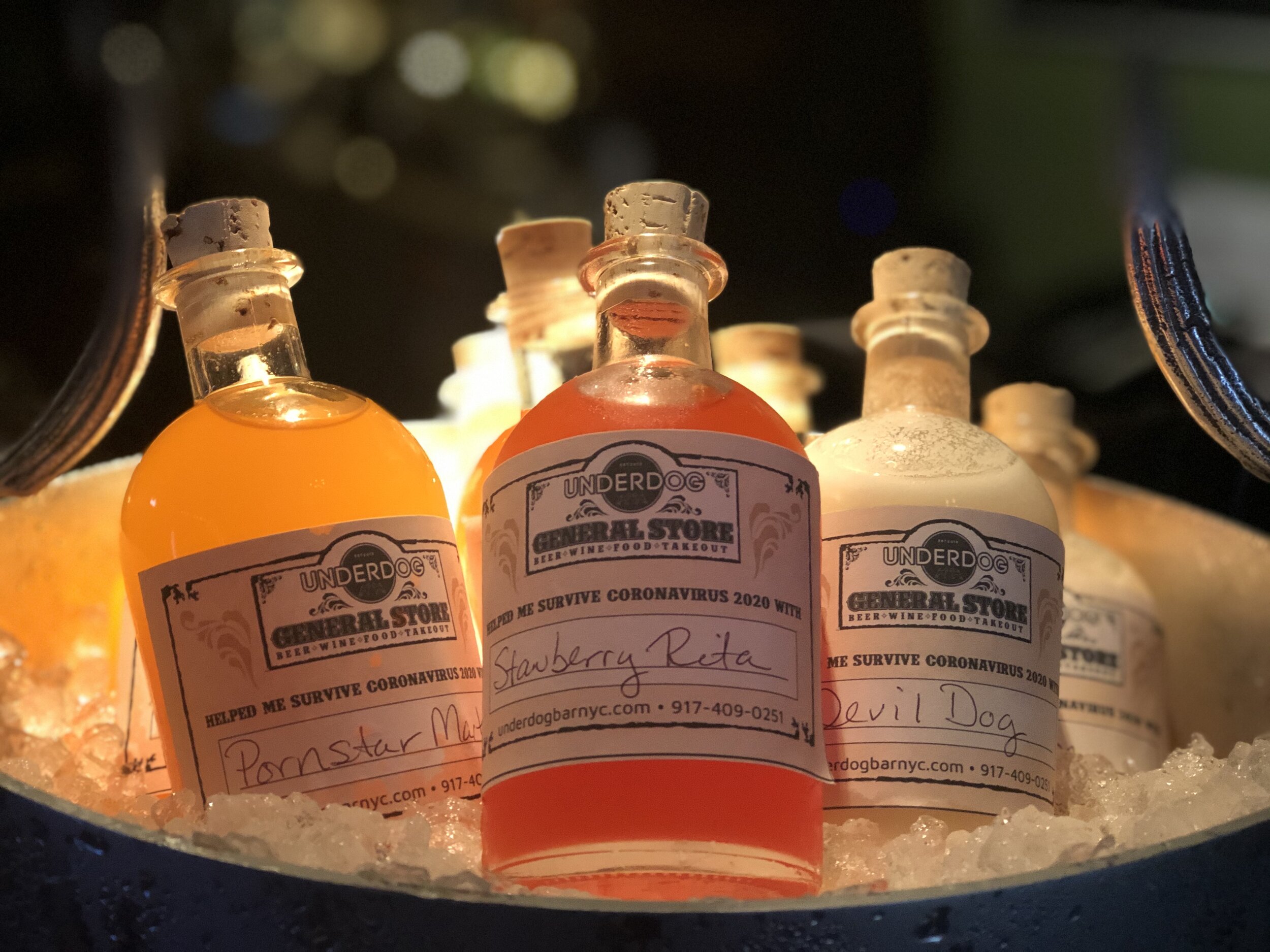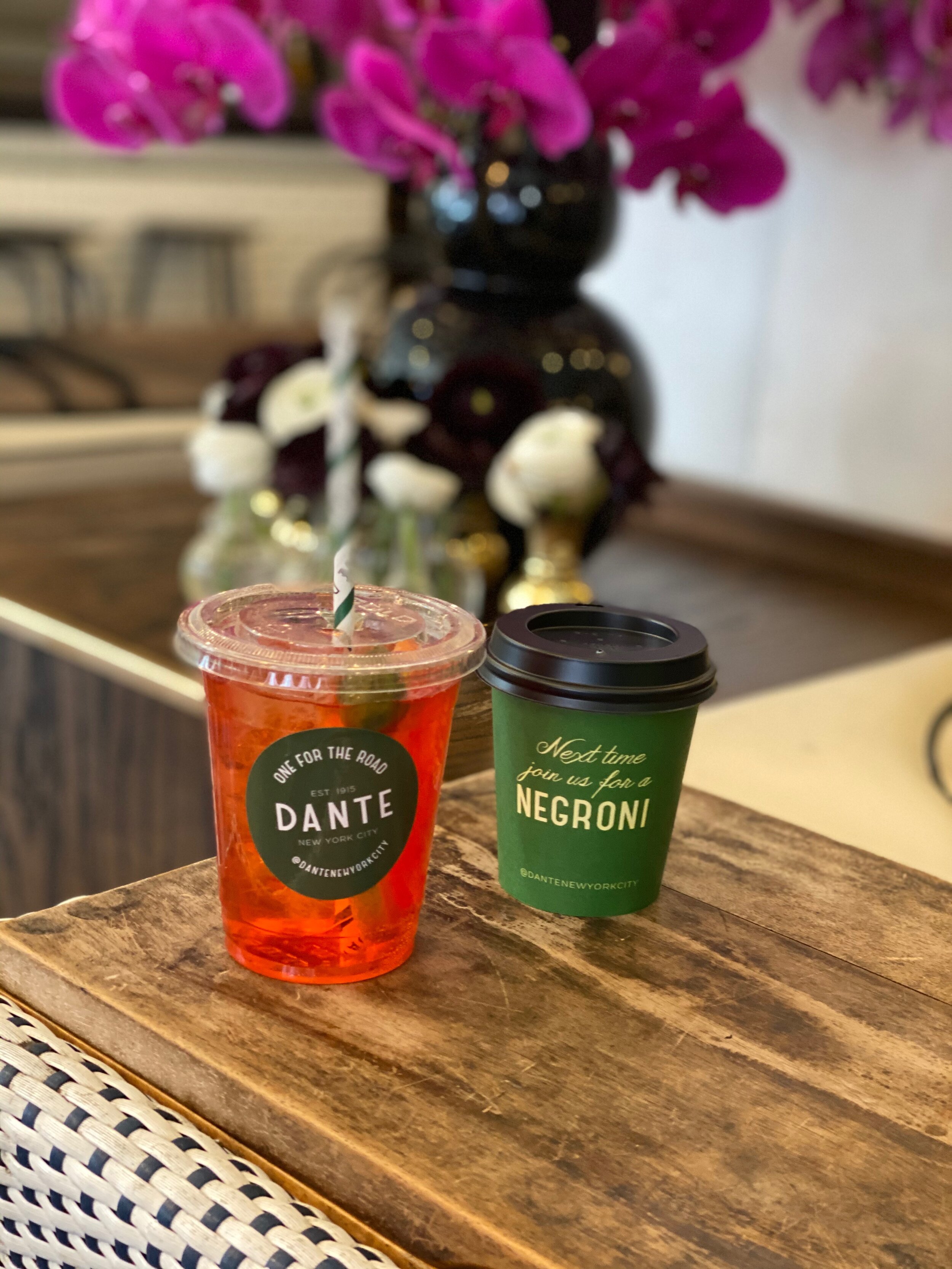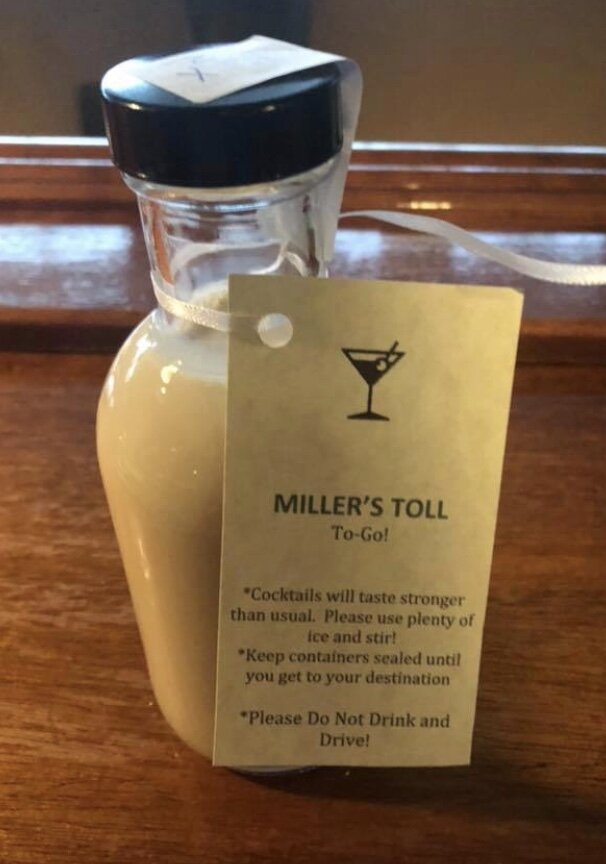Keep Calm and Carry Out: Adjusting Cocktails For Takeout and Delivery
Cocktails to go are a bandaid for bleeding bar businesses, but there are procedural and safety issues to consider
carry out cocktails at Underdog, NYC - photo by Brooke Baker
Laura Newman, winner of the prestigious World Class bartending competition in 2018, and the first woman to hold the honor, is accustomed to being able to take on a challenge head-first. But this week has seen Newman, as well as myriad bar owners and bartenders across the globe, engaged in a wholly different kind of problem-solving.
“I find myself the owner of a cocktail catering company…” reads the subject line of an email from Newman, owner of Birmingham, Alabama’s Queen’s Park.
Every day new states are being added to the growing list of those whose restaurants and bars must close their doors to eat-in or drink-in patrons to curb the spread of COVID-19. Newman is one of many owners who are rewriting business models and operating procedures on the fly for their restaurants and bars, as new state liquor laws in the US are being enacted daily to accommodate alcohol-to-go.
Some states have limited this practice to wine and beer sales only, but others, including California, New York, and Vermont, (as of press time) have allowed the possibility for owners to also sell takeout and delivery selections from their cocktail lists.
Cocktails are an ephemeral sort, generally meant to be drunk well-chilled, and within a short time of having been prepared. So, for many bar owners working within the new system, it’s not just a simple matter of preparing drinks according to the usual specs and putting them in a plastic cup with a straw. (Furthermore, open container laws have generally not changed.)
But bar owners and bartenders are also a rolling-with-the-punches sort, crisis or no crisis. “As each day goes by, we're trying to adapt to these unpredictable circumstances and reinvent the wheel,” says Andrea Grujic of Astoria Queens’ The Highwater, appropriately named from the expression “come hell or high water.”
Here are some of the ways that several bars still in the cocktail business this month are demonstrating creative workarounds in the new system, from glassware to garnish.
cocktails to go at Highwater
Glassware and Packaging
A Martini without a Martini glass is just bracingly cold gin. If there’s no tropical mug, does it even count as tiki? Certain glasses define their cocktails, but in the new era of takeout cocktails, “sealable” is the new appeal, as bars have employed everything from coffee cups with lids, to jelly jars, to soda bottles, to plastic milk cartons.
Lisa Harrington had sourced mini bottles in anticipation of the closure for her Bennington, Vermont bar The Miller’s Toll, and is finding customers appreciate the novelty and aesthetic: “People have been loving the bottles,” she says, “likening them to Alice in Wonderland potions.” Also a useful metaphor for our new reality—what feels to many like a parallel universe.
Newman has also offered Queen’s Park’s actual glassware for sale alongside her takeout selections. “We have a pig-shaped tiki mug,” she says, which has sold incredibly well in the early days to loyal patrons wanting to help keep her afloat. “We’ve already had to place another order for more.”
Amazon is still a go-to source for all things, including takeout packaging options for bar owners, but there are several independent online retailers who specialize in containers of all kinds. These include Ebottles, McKernan Packaging, Berlin Packaging, and SKS Bottle and Packaging.
Batching advice
Cocktails that are made from all spirit—Martinis, Manhattans, and Negronis, for example—can typically be batched in large volumes and simply portioned to order to be chilled later, which is a practice that can save time for bartenders in the heat of service. Many bars are now finding this especially useful for preparing cocktails for takeout and delivery. For example, New York City’s Dante is one of the world’s most lauded bars, but it also can be one of the most crowded to drink in. In the age of COVID-19, several of the bar’s signature cocktails can even be purchased in large batches to enjoy in the comforts of home, including multiple Negroni and Martini selections which are scaled for three or more servings.
Patrick Smith, Bar Manager at The Modern, whose cocktail program employs batching, offers the following guidance: “Once you have a balanced cocktail recipe, it’s easy to translate it into a series of ratios for your batch. I like to start with traditional ounce measurements, and then break it down into ‘parts’ so you can measure in whatever bulk quantity you need.” For example, a Martini made with 3 ounces of gin and ½ ounce of dry vermouth would have 6 parts to 1 part each of those ingredients, whether you are measuring parts in cups, liters, or gallons.
To portion, know the yield of the base recipe, typically between 3 and 5 ounces for most cocktails, and bottle and label accordingly whether you are offering a single serving cocktail or bottle service for six.
The Highwater has employed this technique across all of its takeout selections. “At first, each cocktail was made and bottled to order which became a little hectic once the virtual happy hour rush kicked in,” says Grujic. Now, “each cocktail that we offer is pre-batched for the day and diluted the same way as if we were in real time service—by shaking or stirring.” Ice is offered on the side where appropriate, along with a paper parasol in the spirit of the bar’s “Quarantiki” vibe.
for-the-road cocktails at Dante, NYC
Some assembly required
While many patrons are finding novelty in sipping a cocktail from non-traditional glassware, some bars are offering guidance on how to complete the cocktail sipping experience outside the bar once someone it’s been home—whether by some aspect of dilution, temperature, garnish, or adding an additional topping ingredient that wouldn’t travel well if fully assembled, like soda, tonic, or sparkling wine.
“For every drink I am giving instructions,” says Brooke Baker of Manhattan’s Underdog. “Each one we have has needed a slightly different spin on it. If it is a stirred drink I will slightly under dilute it and instruct the guest to give it a quick stir. If the drink requires a topper like prosecco, I would have them buy a bottle of prosecco at a discounted rate from us, with instructions on how to combine it with the drink, and how much to use.”
In Alabama, prepared cocktails can’t be sold as takeout in the current system, but Newman has found a way to still provide cocktails to her Queen’s Park clientele, via do-it-yourself assembly, where alcoholic and non-alcoholic components of a cocktail must be sold separately and combined at home: “I have gone from being a bar owner to the owner of what is essentially a liquor store and non-alcoholic cocktail catering company.” Bars in Alabama can sell liquor in its original packaging, “so we bought a ton of mini bottles,” she says, which are offered alongside vacuum-sealed packets of the non-alcoholic elements of her cocktails.
Similarly, Mike Vacheresse, owner of Travel Bar in Carroll Gardens, Brooklyn, is offering separate containers of sour mix for shaken drinks like whiskey sours. Very much the bar dad, he takes the time to explain to each patron stopping by for (hygienic!) pickup how to shake the drink at home, and how to use the garnishes he packs on the side.
Garnish
Speaking of, garnishes are traditionally the final element of cocktail construction, adding visual appeal and aromatics, and acting as a sort of spokesperson for what to expect from the cocktail it adorns. However, in the era of takeout cocktails, with the exception of tiki umbrellas, they may be the element most subject to sacrifice.
Miller’s Toll cocktail with instructions, photo by Lisa Harrington
“For Negronis I am giving out whole oranges so that they can garnish at home,” says Baker. “Otherwise I am skipping the garnish. Mostly for (sanitation’s) sake. I do tell (customers) what the garnish should be and how to prepare it if needed.”
Safety Concerns
Restaurants and bars are among those businesses deemed essential, but as such those still working must be extra cautious in preparing takeout and delivery orders. Baker says she’s wearing gloves and a mask while prepping, and double sanitizing all tools and containers in advance.
Harrington also identified another potential risk factor for takeout cocktails from her angle in Vermont, and a possible solution: “We ended up making our traditional drinks without ice, (serving them) room temp to prevent drinking in the car on the way home, adding a sticker to seal the bottle, directions on how to prepare the cocktail, and a warning to not open before getting to their destination and not to drink and drive.”
If takeout cocktails can help bars and restaurants stay in business during this time, however, that may be all the cherry on top we need.




